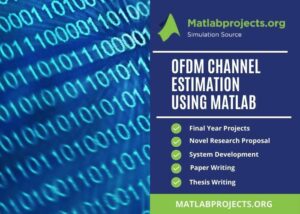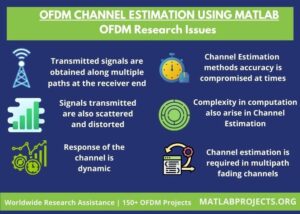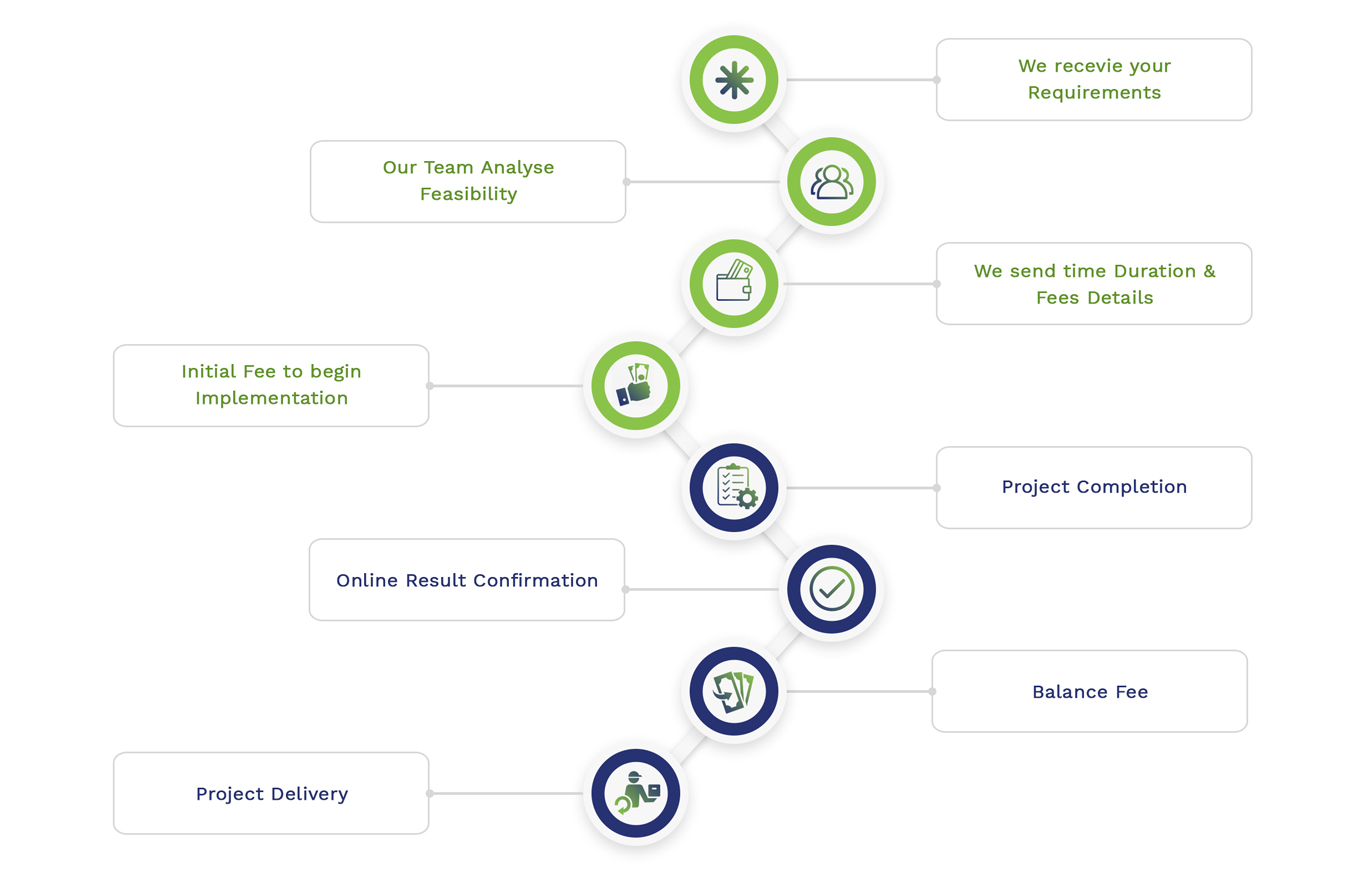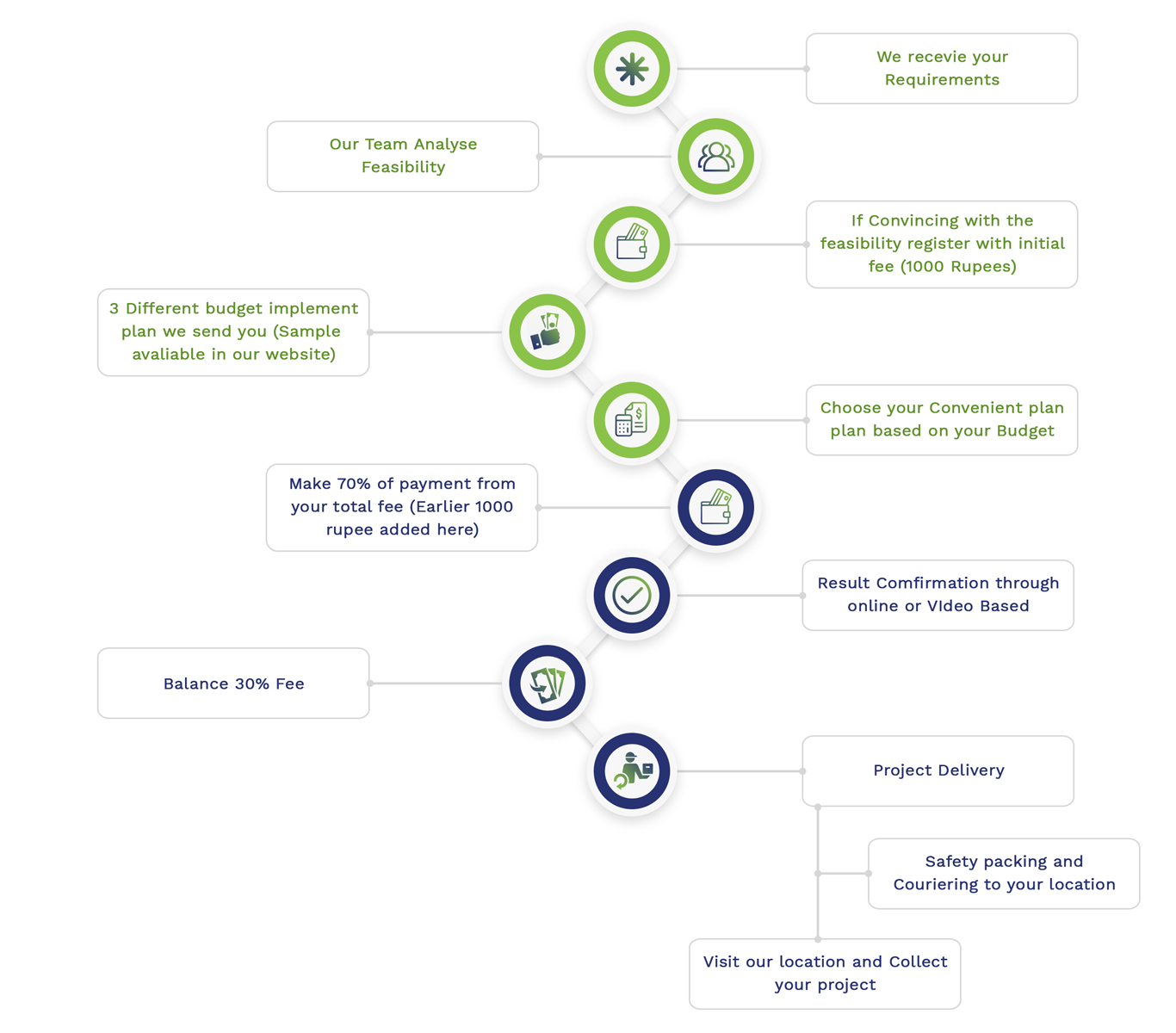Upon going over a radio channel in wireless systems, the transmitted signal is obtained by receivers. To retrieve the data with traditional coherent receivers, the channel’s impact on the transmit signals has to be evaluated. The transmitted signals can be recovered as long as the receivers precisely anticipate how the channels alter the message signal which is nothing but a part of channel estimation. This article will provide you with a deep insight into OFDM channel estimation using MATLAB Simulink.
Orthogonal Frequency-Division Multiplexing, commonly called OFDM, has emerged as a potential option for many reasons like the following

- Fulfill the demands of always raising user demands
- Fulfill the standards of the advanced networks of the future.
- The OFDM system has several benefits, including great spectral efficiency and strong fiber dispersion endurance
- It also provides for resource allocation flexibility
- Among other things, low cost and resistance to Inter-Symbol Interference (ISI) is also a major advantage of OFDM
In wireless systems, channel estimation seems to be a difficult task. The radio network, unlike the other controlled media, is highly active. The broadcast signal is subjected to many harmful effects on its way to the receiver, which distort the message and mostly restrict the system’s performance.
Let us first start by addressing the basics of channel estimation
What is channel estimation in wireless communication?
- Channel estimation is a technology that is used to greatly increase the system performance, notably for 4G and Long Term Evolution (LTE) systems
- It is an important aspect of wireless communications
- OFDM symbols with the Time-Varying Channel Frequency Response are used to estimate the channel
With more than two-decades-long experience in guiding research projects in OFDM Channel estimation using MATLAB, we are highly qualified and skilled to guide you throughout your research in the field. We are here to provide you with expert answers to some of the leading research questions in OFDM Channel estimation. To prove this point we have given answers to certain common OFDM research questions below
What is channel estimation in OFDM?
- All orthogonal frequency division multiplexing (OFDM)-based wireless transmission receivers rely on channel estimation
- Either least squares or minimum mean square error (or MMSE) dependent on pilot aided frequency-domain channel estimation algorithms are used
Since this radio channel is frequency-specific and time-changing for wide mobile communication networks, dynamic channel estimation is required for OFDM demodulation. Also, it is to be remembered that the accuracy of channel estimation has a direct impact on the system’s performance and other parameters like Bit Error Rate. Let us now talk about OFDM Modulation and channel model propagation
OFDM Modulation and Propagation Channel Models
As a researcher in the field of OFDM, you might have already been familiar with the procedures in OFDM modulation and signal propagation. Even then we cover all aspects from basics. In this regard, the steps involved in OFDM Modulation and channel model propagation are mentioned below
- Input from the transmit grid is sent for OFDM modulation which happens through the following specifications
- lteOFDMInfo
- lteOFDMModulate
- With the transmit waveform so obtained, the LTE channel models are chosen
- lteHSTChannel
- lteFadingChannel
- lteMovingChannel
- Finally the receive waveform is obtained at the output
It is highly important for a researcher to equally invested time in understanding the technical aspects related to the functioning of modulation and propagation as stated here. For this purpose, you can interact with our technical experts who are ready to give you a complete explanation of all aspects that you demand. Let us now talk about channel modeling in OFDM
OFDM Channel Modelling
It is significant to note here that OFDM transmission propagation happens across a noisy channel using multi-path fading. For this purpose, the following technical aspects are also considered
- Time-domainx(n)and corruptedy(n)OFDM signal
- Additive White Gaussian Noise or AWGN w(n)
- Channel impulse response or g(n)
With references from noteworthy research sources and benchmark journals along with a strong foundation from standard books, we will provide you access to many such important sources for you to get a complete and accurate picture of all aspects of OFDM channel models. Let us now see the various kind of Channel estimation in OFDM
Types of OFDM Channel Estimation
There are two types of channel estimate algorithms for OFDM-based technologies – blind and non-blind about which we have detailed below
- Blind channel estimate processes depend on the statistical nature of signals received and involve a lot of information. As a result, their efficiency in fast-fading channels is severely harmed
- In contrast, in nonblind channel estimation techniques, the receivers have access to past channel estimations or a portion of the transmitted signals at the receiving end
With technical notes and a description of practical implementations of these types, you can better comprehend their advantages. In this regard, we are here to provide you with all the essential result details of our successful OFDM projects. Let us know talk about the OFDM Channel estimation research issues
Research Issues in OFDM Channel Estimation
- The transmitted signals are obtained along multiple paths at the receiver end
- The signals transmitted are also scattered and distorted
- Response of the channel is dynamic due to the mobile nature of transmitters and receivers and objects
- Signals become spread in angle, time, and frequency due to the aspects of mobility, multipath propagation, and scattering
- In Channel Estimation methods accuracy is compromised at times
- Complexity in computation also arise in Channel Estimation
- For enhanced performance Channel estimation is required in multipath fading channels
- Signal spreading are directly correlated with channel selectivity and have an impact on received signals
Hence, as a result, the performance of Channel estimation methods and algorithms are in direct proportion with the statistics of certain parameters stated above. We have dealt with all these issues and found innovative solutions to tackle them. Get in touch with us to have access to these methodologies which are approved to be potential solutions to OFDM research problems. Let us now see about the implementation of OFDM Channel estimation
How to implement OFDM channel estimation using Matlab?
- Differential modulation schemes could be used to eliminate channel estimation; nevertheless, these systems have a poor bit rate and a cost of 3–4 dB SNR
- If a base station does channel estimation and provides signals that are previously distorted, then the estimation of channels at the user’s terminal could be bypassed in some instances
The purpose of this specification is to represent data processing of the transit and control channels, comprising of multiplexing, coding scheme, and interleaving, and to establish the following
- Uplink and downlink transport pathways and control data
- Channel coding techniques
- Rate matching
With this brief note on OFDM Channel estimation and its implementation, it becomes crucial to discuss the methods involved in it. So let us now look into the Channel estimation methods in OFDM
OFDM Channel Estimation Methods
In OFDM systems, there are numerous basic strategies for estimating the radio channel. Time or frequency domain samples can be used in the estimation approaches. These estimators differ in terms of the following
- Efficiency
- Complexity
- Prioritized data
- Applicability in practice
Subcarriers correlations in Frequency, time, and Spatial Domains could be obtained from previous data. The primary work focuses on the frequency and time-domain channel estimates, as well as block and comb type pilots.
- The Minimum Mean Squared Error, or MMSE, is a highly computationally intensive algorithm that uses second-order statistics of signals
- Least squares, or first-order statistics, utilized in this simulation
- Frequency domain estimation techniques of the block type as an example
It is quite interesting to note that much advancement in recent years has brought notable advantages changes in the Channel estimation techniques. To understand all the aspects of Channel estimation you would probably need an expert team to assist you.
Our technical team consists of world-class certified research experts, writers, developers, and qualified engineers who update themselves regularly. So we are very much capable of providing you with ultimate research support. Let us now look into the recent methods in OFDM Channel estimation
What are the current methods used for OFDM Channel estimation?
- Channel estimation methods provide for the receivers to predict the channel’s effect on any signals
- Pilot assisted methods are the simplest and realistic approach in which symbols known to the receivers are called pilots
- It shows better performance in a channel fading environment
Usually, our technical experts provide simple and practical explanations which are very much like to by researchers from all around the world. Let us now look into two major methods used in OFDM Channel estimation using matlab at the present
- Semi blind (with pilots) –
- This method relies on pilots and channel statistics
- It also takes up an intermediate position
- Time-varying Channel estimation of neural network methods are tested using this technique
- This method involves pilot based Channel estimation and then lead to channel tracking
- Blind – without pilots
- The blind methods are primarily based on the statistics of the channel
- It does not consider pilots and there is no requirement for training sequences
- Second and other higher-order statistics are used in blind Channel estimation techniques
- Search methods make use of the less complex and fast rates of convergence
- These are difficult for real-time implementations
Essentially the field knowledge in implementation of these methods and the real-time execution gives more experience and Research data. To have access to such a huge amount of massive reliable data for OFDM research projects, you shall check out our website. Let us now see the comparison between single and multi-carrier systems in Channel estimation
OFDM Channel Estimation for Single Carrier vs. Multi Carrier Systems
- In single-carrier communication systems, channel estimation has a long and distinguished background
- The CIR is often described as that of an uncertain time-varying FIR filter in these applications, with coefficients that must be computed
- Many of the single-carrier channel estimating techniques may be used for multi-carrier networks
- The unique qualities of multi-carrier transmission, on the other hand, open up fresh possibilities for developing novel techniques for multi-carrier system channel estimation
A better picture of these Channel estimation systems and their associated algorithms, protocols, and other technical aspects can be readily provided to you by our excellent team of engineers. We are also ready to solve all your doubts in OFDM research and simulation. Here let us have an overview of OFDM channel estimation using Matlab
Overview of MATLAB for OFDM Channel Estimation
MATLAB’s goal in channel estimation is simulating a realistic and precise estimation of OFDM channels. To help with signal recovery, you can implement channel estimation techniques to calculate the channel responses. The following are the components that can be performed using MATLAB tools
- Consider a radio channel with multiple paths
- On each path, the Jakes model can be used
- Channel estimate based on CNN
You can have a detailed view of the importance of MATLAB in OFDM Channel estimation by looking into the tools, libraries, and associated toolboxes present in it for the purpose. So let us look into them below,
MATLAB Tools, Toolboxes, and Functions available for the following types of channel estimation
- Toolboxes for Downlink, Sidelink, Narrowband, and uplink channel estimation are available with MATLAB
Thus MATLAB is presently an important tool for OFDM channel estimation simulation. We have been working with MATLAB tools since its launch and so we are highly skilled in using all MATLAB toolboxes efficiently. What are the MATLAB toolboxes for OFDM Channel estimation?
MATLAB Toolboxes for OFDM Channel Estimation
- 5G and 5G LTE toolbox
- Communication and deep learning toolboxes
These are the prominent toolboxes in MATLAB that can be utilized for OFDM Channel estimation and its simulation. You can interact with our research expert for handling these toolboxes more effectively. What are the LTE toolboxes for OFDM Channel estimation?
LTE Toolbox for OFDM Channel Estimation
- The digital multi-carrier modulation technology used by the LTE Toolbox package is orthogonal frequency division multiplexing (OFDM)
- An OFDM system relies heavily on channel estimation
- It’s being used to boost the capability of orthogonal frequency division multiple access (OFDMA) networks by lowering their rate of bit errors
- LTE employs cell-specific reference signals or pilot symbols that are injected in time and frequency to aid in the channel estimation characteristics
- These pilot symbols give a channel estimation at specific points within a subframe
- The channel can be estimated over any number of subframes using interpolation
Many a time researchers reached out to us for better technical notes on using such toolboxes. We give assurance to make your research more interesting. Let us now talk about LTE downlink Channel estimation
LTE Downlink Channel Estimation and Equalization
Through our website on OFDM channel estimation using MATLAB we demonstrate how to construct a data frame and pass it over a fading channel, and conduct channel estimation and equalization using the LTE Toolbox. So you shall reach out to us with more confidence as we promised to take your research successfully to the next level. What are the LTE Toolbox functions useful in OFDM Channel estimation?
LTE Toolbox Functions for OFDM channel estimation
- lteULChannelEstimateNPUSCH – NPUSCH channel estimation
- lteULChannelEstimatePUCCH1, lteULChannelEstimatePUCCH2 and lteULChannelEstimatePUCCH3 – PUCCH format 1, 2 and 3 uplink channel estimation respectively
- lteSLChannelEstimatePSBCH – PSSCH sidelink channel estimation
- lteULPerfectChannelEstimate – Uplink perfect channel estimation
- lteULChannelEstimate – PUSCH uplink channel estimation
- lteDLPerfectChannelEstimate – Downlink perfect channel estimation
- lteDLChannelEstimate – Downlink channel estimation
Our research express have used all these toolboxes prominently and so we are able to give you detailed and gist-like explanations on all such functions stated above. Let us now talk in detail about the deep learning toolbox for OFDM Channel estimation
Deep Learning Toolbox for OFDM Channel Estimation
- With Deep Learning Toolbox and datasets created by 5G Toolbox, we provide you with an example to explain the training methods of a convolutional neural network (CNN) for channel estimation
- The physical downlink shared channel (or PDSCH) demodulation signal for reference is used to conduct channel estimation in single-input single-output (or SISO) mode with the trained CNN (or DM-RS)
Until now we have seen some of the important toolboxes of LTE Network Simulator, deep learning, and MATLAB that are useful for OFDM Channel estimation. Now let us have an overview of the fundamentals of Channel estimation methods
Overview of OFDM Channel Model
The general model design for channel estimating is to incorporate given reference pilot symbols into the broadcast transmission and then use such pilot symbols to estimate the remaining channel responses.
- Create a channel model for Simulation and Simulate PDSCH Transmission
- Neural Network Learning
- Analyze and represent alternative channel estimates
With more such details about the various aspects of Channel estimation in OFDM, our website is filled with a lot more information that is most needed for your research. Let us not talk about neural network training
Neural Network Training
The following are the steps in neural network training
- Creating data
- Dividing it into training and validation sets
- Defining CNN infrastructure
- Choosing the options for training, optimization methods, and learning rate
Network training includes the following aspects.
- The data generation is set to generate 256 training or datasets sets
- This is enough data to train a functioning channel estimation network on such a CPU in an acceptable length of time
- The pre – trained model uses 16,384 training samples for comparison
- The CNN model’s training data has a fixed dimensionality
- The network could only process grids with 612 subcarriers, 14 OFDM symbols, and one antenna
- As a result, the model can hardly work with a fixed or available bandwidth, cyclic prefix value, and one receiver antenna
After successful training, examine the model’s composition and layers. There are five convolutional layers in the model. The input layer requires matrices with a dimension of 612 by 14 (612 is the number of subcarriers and 14 is the number of OFDM symbols) as these real and imaginary parts of the complex grids are entered individually, every component is real. How to create a channel model for simulation?
Create Channel Model for Simulation
For the creation of channel models for the purpose of simulation, the following steps and approaches can be carried out
- You can specify how noisy the simulation is in decibels
- Included in here are the PDSCH settings as well as the DM-RS configuration, which must be loaded in order to run the simulation
- The returning objects carriers are valid carrier configuration objects, and pdsch is a SISO PDSCH configuration structure
- Set channel characteristics and build a TDL channel model
- You can also adjust these settings as mentioned below, later to identify specific estimator channel responses
- Quite important parameters for channel modelling simulation are listed below
- Transmit Antennas Number and Receive Antennas (number)
- Spread of Delay
- Doppler Shift Maximum and Seed
- Waveform Information Sample Rate
We are here to support you with writing proper codes and executing various algorithms for the purposes mentioned above efficiently. Let us now talking detail about PDSCH transmission Simulation
Simulate PDSCH Transmission
Follow these procedures to simulate a PDSCH transmission
-
- Add DM-RS symbols to the PDSCH resource grid
- Modulate OFDM (Official Frequency Division Multiplexing)
- Use the channel model to send a modulated waveform
- Replace the white Gaussian noise with a white Gaussian noise
- Synchronize your time perfectly
- Demodulate OFDM signals
You can get complete details on each of these steps and their associated algorithms and simulation software with us. Let us now have a look into various Channel estimation methods
Compare and Visualize Various Channel Estimations
- The outcomes of ideal, realistic, and neural network estimates of the very same channel model can be performed and compared.
- You can use the nrPerfectChannelEstimate method with path gain values given by the channel to create optimal channel estimation.
- For each estimation method, compute the mean squared error (MSE).
- Use the channel filtration taps to show the separate channel estimations and actual channel realizations
- Linear interpolation is outperformed by both the realistic and neural network estimators
For more details on comparison and visualization of different Channel estimation techniques reach out to us. You can talk to our search experts on any kind of queries related to OFDM Channel estimation. We assure you that we will provide you with reliable solutions instantly. What are the OFDM Channel estimation simulation parameters?
Simulation Parameters for OFDM Channel Estimation
The following are the major simulation parameters used in Channel estimation of OFDM signals
- Channel model and characteristics
- Total number of multipath channels and base station antennas
- Uses and subcarriers number
- Pilot allocation method and consecutive OFDM symbols
All our previous OFDM projects have shown better results with respect to these parameters for the simulation. Get in touch with us to have more details on our projects about OFDM Channel Estimation Using Matlab. We have got expert faculty with research guidance focused on holistic development.
Subscribe Our Youtube Channel
You can Watch all Subjects Matlab & Simulink latest Innovative Project Results
Our services
We want to support Uncompromise Matlab service for all your Requirements Our Reseachers and Technical team keep update the technology for all subjects ,We assure We Meet out Your Needs.
Our Services
- Matlab Research Paper Help
- Matlab assignment help
- Matlab Project Help
- Matlab Homework Help
- Simulink assignment help
- Simulink Project Help
- Simulink Homework Help
- Matlab Research Paper Help
- NS3 Research Paper Help
- Omnet++ Research Paper Help
Our Benefits
- Customised Matlab Assignments
- Global Assignment Knowledge
- Best Assignment Writers
- Certified Matlab Trainers
- Experienced Matlab Developers
- Over 400k+ Satisfied Students
- Ontime support
- Best Price Guarantee
- Plagiarism Free Work
- Correct Citations
Expert Matlab services just 1-click

Delivery Materials
Unlimited support we offer you
For better understanding purpose we provide following Materials for all Kind of Research & Assignment & Homework service.
 Programs
Programs Designs
Designs Simulations
Simulations Results
Results Graphs
Graphs Result snapshot
Result snapshot Video Tutorial
Video Tutorial Instructions Profile
Instructions Profile  Sofware Install Guide
Sofware Install Guide Execution Guidance
Execution Guidance  Explanations
Explanations Implement Plan
Implement Plan
Matlab Projects
Matlab projects innovators has laid our steps in all dimension related to math works.Our concern support matlab projects for more than 10 years.Many Research scholars are benefited by our matlab projects service.We are trusted institution who supplies matlab projects for many universities and colleges.
Reasons to choose Matlab Projects .org???
Our Service are widely utilized by Research centers.More than 5000+ Projects & Thesis has been provided by us to Students & Research Scholars. All current mathworks software versions are being updated by us.
Our concern has provided the required solution for all the above mention technical problems required by clients with best Customer Support.
- Novel Idea
- Ontime Delivery
- Best Prices
- Unique Work
Simulation Projects Workflow

Embedded Projects Workflow



 Matlab
Matlab Simulink
Simulink NS3
NS3 OMNET++
OMNET++ COOJA
COOJA CONTIKI OS
CONTIKI OS NS2
NS2






